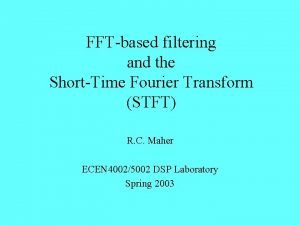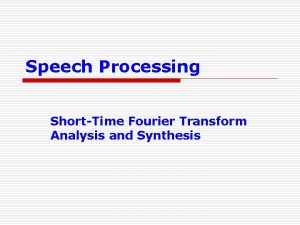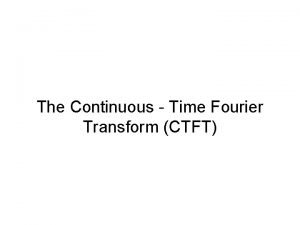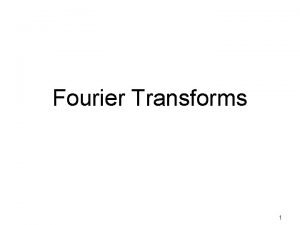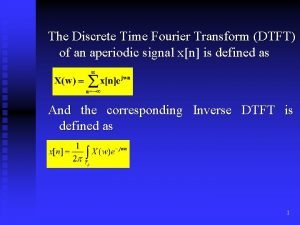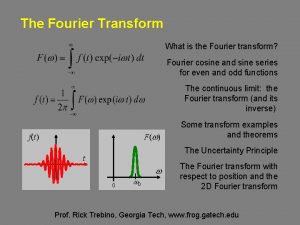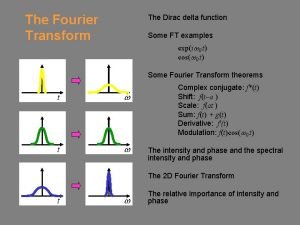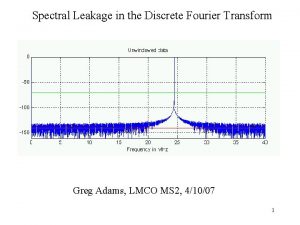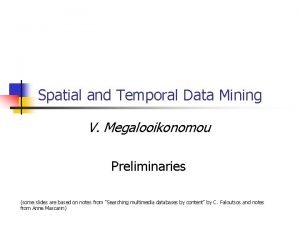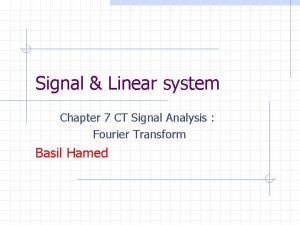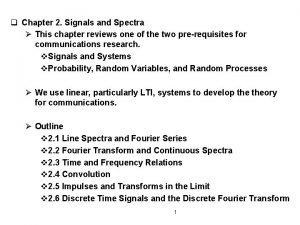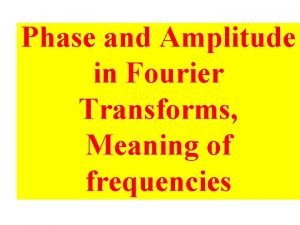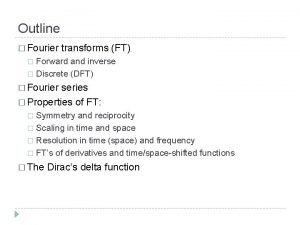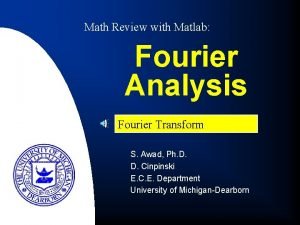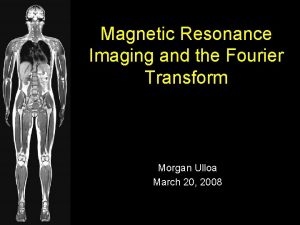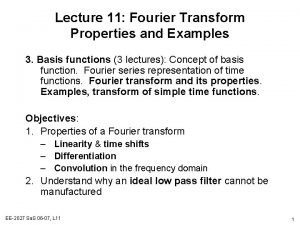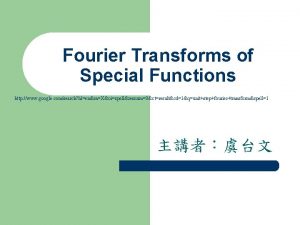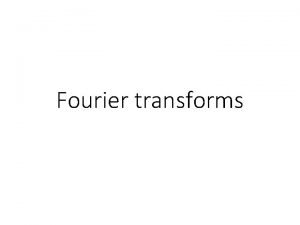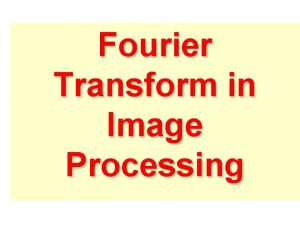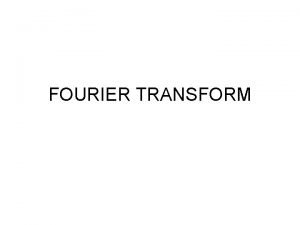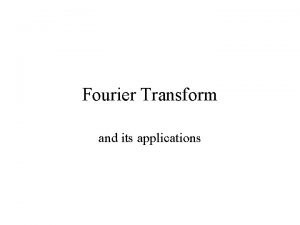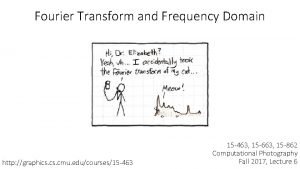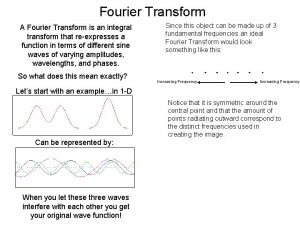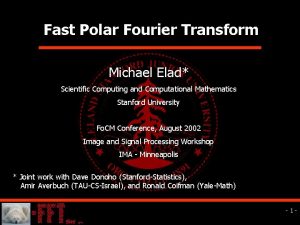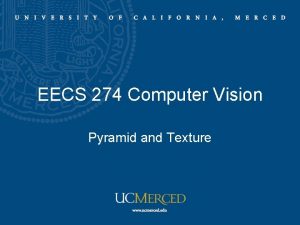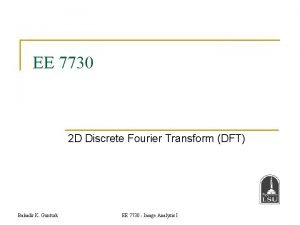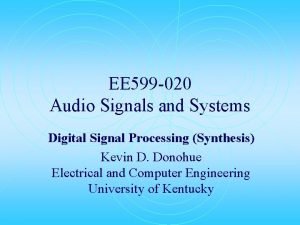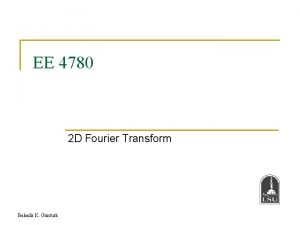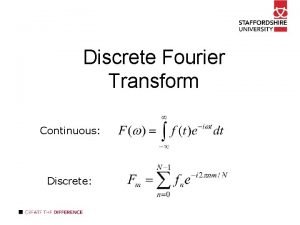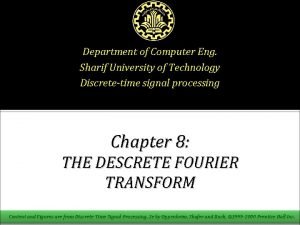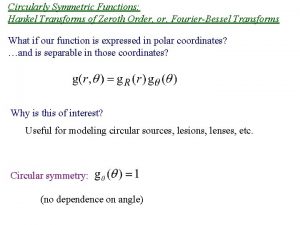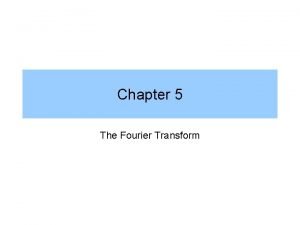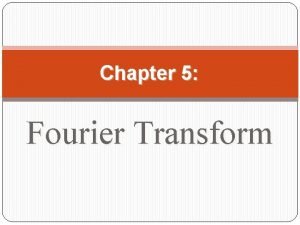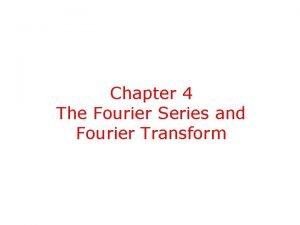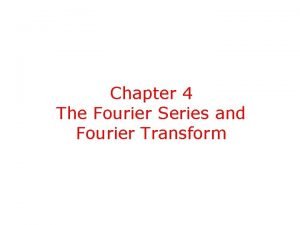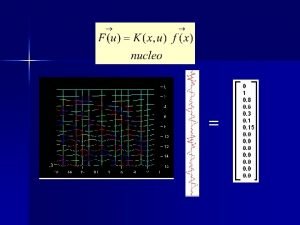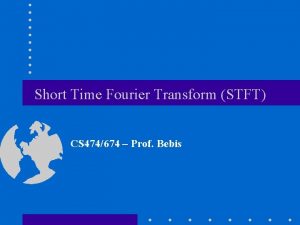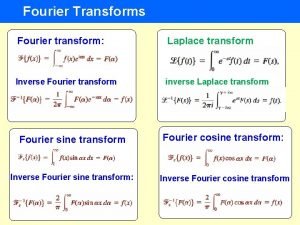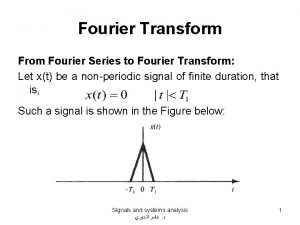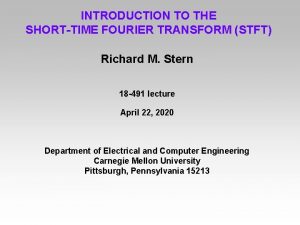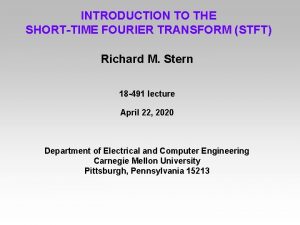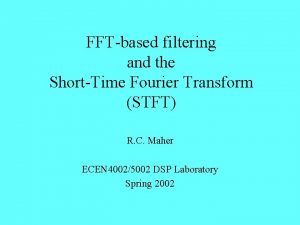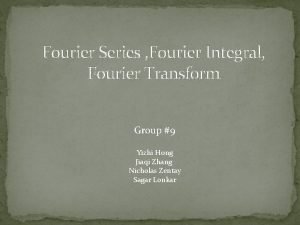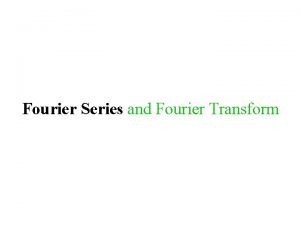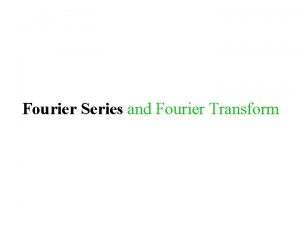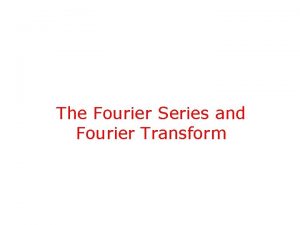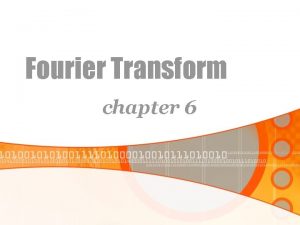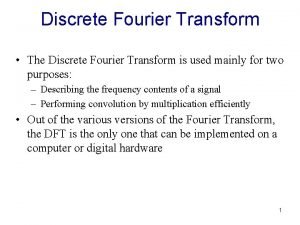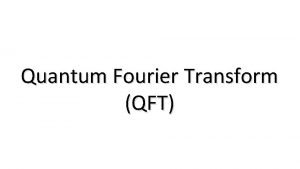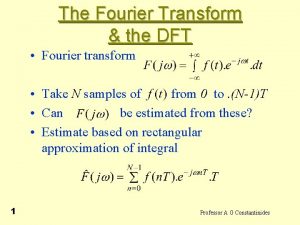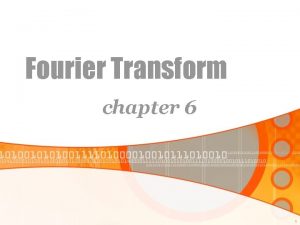Short Time Fourier Transform STFT Fourier Transform Fourier


























![Example f(t) [0 – 300] ms 75 Hz sinusoid [300 – 600] ms 50 Example f(t) [0 – 300] ms 75 Hz sinusoid [300 – 600] ms 50](https://slidetodoc.com/presentation_image_h2/a9b50b9367f76e77282ccb0d95ba8968/image-27.jpg)









- Slides: 36

Short Time Fourier Transform (STFT)

Fourier Transform • Fourier Transform reveals which frequency components are present in a function: (inverse DFT) where: (forward DFT)

Examples

Examples (cont’d) F 1(u) F 2(u) F 3(u)

Fourier Analysis – Examples (cont’d) F 4(u)

Limitations of Fourier Transform 1. Cannot provide simultaneous time and frequency localization.

Fourier Analysis – Examples (cont’d) Provides excellent localization in the frequency domain but poor localization in the time domain. F 4(u)

Limitations of Fourier Transform (cont’d) 1. Cannot provide simultaneous time and frequency localization. 2. Not very useful for analyzing time-variant, nonstationary signals.

Stationary vs non-stationary signals • Stationary signals: time-invariant spectra • Non-stationary signals: time-varying spectra

Stationary vs non-stationary signals (cont’d) Stationary signal: Three frequency components, present at all times! F 4(u)

Stationary vs non-stationary signals (cont’d) Non-stationary signal: Three frequency components, NOT present at all times! F 5(u)

Stationary vs non-stationary signals (cont’d) Non-stationary signal: Perfect knowledge of what frequencies exist, but no information about where these frequencies are located in time! F 5(u)

Limitations of Fourier Transform (cont’d) 1. Cannot provide simultaneous time and frequency localization. 2. Not very useful for analyzing time-variant, nonstationary signals. 3. Not appropriate for representing discontinuities or sharp corners (i. e. , requires a large number of Fourier components to represent discontinuities).

Representing discontinuities or sharp corners

Representing discontinuities or sharp corners (cont’d) FT

Representing discontinuities or sharp corners (cont’d) Original Reconstructed 1

Representing discontinuities or sharp corners (cont’d) Original Reconstructed 2

Representing discontinuities or sharp corners (cont’d) Original Reconstructed 7

Representing discontinuities or sharp corners (cont’d) Original Reconstructed 23

Representing discontinuities or sharp corners (cont’d) Original Reconstructed 39

Representing discontinuities or sharp corners (cont’d) Original Reconstructed 63

Representing discontinuities or sharp corners (cont’d) Original Reconstructed 95

Representing discontinuities or sharp corners (cont’d) Original Reconstructed 127

Short Time Fourier Transform (STFT) Segment the signal into narrow time intervals (i. e. , narrow enough to be considered stationary) and take the FT of each segment. Each FT provides the spectral information of a separate timeslice of the signal, providing simultaneous time and frequency information.

STFT - Steps (1) Choose a window function of finite length (2) Place the window on top of the signal at t=0 (3) Truncate the signal using this window (4) Compute the FT of the truncated signal, save results. (5) Incrementally slide the window to the right (6) Go to step 3, until window reaches the end of the signal

STFT - Definition Time parameter Frequency parameter Signal to be analyzed 2 D function STFT of f(t): computed for each window centered at t=t’ Windowing function Centered at t=t’
![Example ft 0 300 ms 75 Hz sinusoid 300 600 ms 50 Example f(t) [0 – 300] ms 75 Hz sinusoid [300 – 600] ms 50](https://slidetodoc.com/presentation_image_h2/a9b50b9367f76e77282ccb0d95ba8968/image-27.jpg)
Example f(t) [0 – 300] ms 75 Hz sinusoid [300 – 600] ms 50 Hz sinusoid [600 – 800] ms 25 Hz sinusoid [800 – 1000] ms 10 Hz sinusoid

Example f(t) W(t) scaled: t/20

Choosing Window W(t) • What shape should it have? – Rectangular, Gaussian, Elliptic … • How wide should it be? – Window should be narrow enough to ensure that the portion of the signal falling within the window is stationary. – But … very narrow windows do not offer good localization in the frequency domain.

STFT Window Size W(t) infinitely long: STFT turns into FT, providing excellent frequency localization, but no time localization. W(t) infinitely short: results in the time signal (with a phase factor), providing excellent time localization but no frequency localization.

STFT Window Size (cont’d) • Wide window good frequency resolution, poor time resolution. • Narrow window good time resolution, poor frequency resolution. • Wavelets: use multiple window sizes.

Example different size windows (four frequencies, non-stationary)

Example (cont’d) scaled: t/20

Example (cont’d) scaled: t/20

Heisenberg (or Uncertainty) Principle Time resolution: How well two spikes in time can be separated from each other in the frequency domain. Frequency resolution: How well two spectral components can be separated from each other in the time domain

Heisenberg (or Uncertainty) Principle • We cannot know the exact time-frequency representation of a signal. • We can only know what interval of frequencies are present in which time intervals.
 Tall + short h
Tall + short h Stft
Stft Short time fourier transform
Short time fourier transform Cftft
Cftft Fourier transform of 1
Fourier transform of 1 Discrete time fourier transform
Discrete time fourier transform Fourier transform of product of two functions
Fourier transform of product of two functions Fourier transform of delta(t-t0)
Fourier transform of delta(t-t0) Dft table
Dft table Parseval's identity for fourier transform
Parseval's identity for fourier transform Fourier transform properties table
Fourier transform properties table Line spectrum in signals and systems
Line spectrum in signals and systems Phase meaning
Phase meaning Inverse fourier transform
Inverse fourier transform Matlab ramp function
Matlab ramp function Mri fourier transform
Mri fourier transform Fourier transform properties solved examples
Fourier transform properties solved examples Fourier transform of impulse train
Fourier transform of impulse train Fourier transform of gaussian
Fourier transform of gaussian Fourier
Fourier Properties of fourier transform in digital image processing
Properties of fourier transform in digital image processing 2 pi f t
2 pi f t The fourier transform and its applications
The fourier transform and its applications Inverse fourier transform
Inverse fourier transform Fourier transform
Fourier transform Polar fourier series
Polar fourier series Fourier transform of product of two functions
Fourier transform of product of two functions 2d discrete fourier transform
2d discrete fourier transform Sinc fourier transform
Sinc fourier transform Fourier transform of impulse train
Fourier transform of impulse train Discrete fourier transform
Discrete fourier transform Overlap save method
Overlap save method Circ function fourier transform
Circ function fourier transform Duality of fourier transform
Duality of fourier transform Fourier transform is defined for
Fourier transform is defined for Parseval's equation
Parseval's equation Fourier series multiplication property
Fourier series multiplication property

